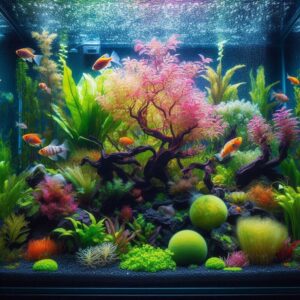Tips for Keeping Your Aquarium Plants Healthy and Beautiful
Aquarium plants may transform any fish tank into a visually appealing, vibrant underwater habitat. They create a visually pleasing backdrop while also boosting the overall health of your aquarium. Aquarium plants require regular care and maintenance to live and thrive. This comprehensive book will teach you everything you need to know about keeping aquarium plants healthy.
Understanding the Importance of Aquarium Plants
Before delving into the nuances of caring for aquarium plants, it’s important to understand why they’re such a good addition to your fish tank. Here are a few reasons why aquarium plants are important:
Oxygen Production: Aquarium plants’ photosynthesis emits oxygen into the air, improving water quality for fish and other marine life.
– Waste Absorption: Plants help to absorb excess nutrients, waste, and pollutants from water, such as ammonia, nitrates, and phosphates, reducing the risk of imbalances and preserving water quality.
– Natural Habitat: Aquarium plants offer refuge and hiding places for your fish, reducing stress and increasing general health.
– Algae Control: A well-planted tank prevents excessive algae growth by competing for nutrients and obstructing light.
Understanding these benefits will encourage you to develop the best maintenance regimen for your aquarium plants.

Choosing the Right Aquarium Plants
Choosing the right plants for your aquarium is critical to its success. Several variables must be considered.
Light Requirements:
Plants have varying light requirements, which are low, medium, and high. Understanding the lighting requirements of your chosen plants will enable you to provide the appropriate illumination. Tank Size: Consider the size and dimensions of your aquarium. Some plants may require taller or larger tanks, but others thrive in smaller spaces. Water parameters: Some plants prefer specific water conditions, such as temperature, pH, and hardness. Check the preferred specifications of your chosen plants to ensure they are suitable for your tank conditions.
Plants can develop slowly, steadily, or fast. Choose one that matches your preferences and is simple to manage.
Java Fern, Anubias, Amazon Sword, and Cryptocoryne are some of the most commonly recommended aquarium plants for beginners.
Creating a Suitable Environment for Your Aquarium Plants
Once you’ve determined which aquarium plants are best suited to your needs, providing them with an acceptable environment is necessary. Here’s how to create an optimal atmosphere for your plants:
Proper lighting is not a luxury; it is essential for the growth of your aquarium plants. Whether you use fluorescent, LED, or specialist plant lights, selecting the appropriate spectrum and intensity for your plants is critical. This ensures that they receive the light required for photosynthesis and growth. Remember not to overlook the importance of light in your aquarium habitat.
Water Circulation: Proper water circulation is essential for aquarium plants’ overall health and growth. Ensure filtration systems and water pumps are placed so nutrients flow and are appropriately distributed.
CO2 Injection: Carbon dioxide (CO2) injection is optional but extremely useful, particularly in high-light planted tanks. CO2 promotes robust plant development and prevents algae outbreaks. Several CO2 injection methods, including DIY yeast-based systems and pressurised CO2 setups, are available.
Maintaining Optimal Water Quality
The well-being of your aquarium plants depends on your diligent attention to water quality. Poor water quality can stunt plant growth and render plants vulnerable to various diseases. Here are some crucial points to consider:
Perform regular water changes to remove pollutants, extra nutrients, and contaminants. Ten to twenty per cent of the tank’s volume should be changed weekly.
Water Parameters: The stability and balance of water parameters are crucial for the health of your plants. Maintaining the recommended range for your plants’ needs is essential. Regular testing for pH, ammonia, nitrites, and nitrates is a proactive step towards a healthy aquatic environment for your plants.
Fertilisation: Certain plants may require additional fertilisation to thrive. Liquid fertilisers or root tabs can provide nitrogen, potassium, and phosphorus.
Algae Control: Proper plant care helps to control algae growth. Decaying or dying leaves should be removed soon to avoid excess nutrients and algae problems. Introduce algae-eating fish or prawns to help keep algae under check.
Pruning and Propagation Techniques
Aquarium plants require regular trimming and propagation to ensure good development and prevent overcrowding. Here are some pointers to bear in mind:
Trimming: It’s not just about removing dead or decaying leaves; it’s about managing the size and shape of your plants. This promotes bushier growth and keeps surrounding plants from being shaded, a key responsibility in plant care.
Many aquarium plants are easily propagated through division, stem cuttings, or runners. Investigate the propagation methods for your plant species to enlarge your collection or replant overgrown plants.
Plant placement: Consider their growth tendencies when arranging the plants in your tank. Leave enough space between plants to allow for growth and avoid overcrowding.

Troubleshooting Common Issues
You may need help caring for your aquarium plants despite your best efforts. Here are a few common problems and solutions:
Yellowing leaves can indicate a food deficit, insufficient illumination, or poor water quality. Adjust the fertiliser, lighting, and watering conditions accordingly.
Algae Overgrowth: If algae overgrow your aquarium plants, check the lighting duration and intensity, water parameters, and fertiliser levels. Adjust these parameters accordingly, and consider introducing algae-eating fish or invertebrates.
Melting Plants: Sudden plant melting frequently indicates insufficient acclimatisation, improper water conditions, or incompatible tankmates. Improve water quality and ensure compatibility with other occupants.
Pests and Diseases: Look for snails, aphids, and fungal infections. Quarantine and treat afflicted plants with aquarium-safe medicines, or seek professional assistance.
Most Popular Questions and Answers
How often should I fertilize my aquarium plants?
The frequency of fertilization depends on the nutrient requirements of your plants. While some plants may require regular fertilization, others can thrive with minimal supplementation. Monitor the growth and appearance of your plants to determine the required frequency.
Can I use regular soil for my aquarium plants?
Regular garden soil may contain additives or fertilizers that can harm your aquarium plants and impact water quality. It is best to use specialized aquatic soil or substrates specifically designed for aquarium use.
Do all aquarium plants require CO2 injection?
Not all aquarium plants require CO2 injection. Low- to moderate-light plants generally do well without additional CO2 supplementation. However, CO2 injection can significantly enhance growth and prevent algae outbreaks for high-light plants or demanding species.
Can I use tap water for my aquarium plants?
Tap water can be used for aquarium plants, but it is essential to remove chlorine and other harmful compounds. Treat tap water with a quality water conditioner, or let it sit for 24 hours before adding it to your aquarium.
How can I prevent algae growth in my aquarium plants?
Proper lighting, nutrient balance, and regular plant maintenance can help prevent excessive algae growth. Introducing algae-eating fish or invertebrates can also help keep algae under control.
Now, armed with the knowledge of how to care for and maintain your aquarium plants, you can create a stunning aquatic oasis that enhances the beauty of your fish tank and provides a healthy environment for your aquatic inhabitants. Your aquarium plants will flourish with proper care and attention, creating a captivating underwater landscape for years.
References
The Ultimate Care Guide For Betta Fish. https://aquaticbuddy.com/betta-fish/care/
Aquarium Thriving: Pro Tips For Long-Term Success. https://ourmarinespecies.com
The post How to Properly Care for and Maintain Your Aquarium Plants appeared first on Unity Pets.
The Article How to Properly Care for and Maintain Your Aquarium Plants Was Found On https://limitsofstrategy.com


17 Responses
I really enjoyed reading your post about the significance of aquarium plants. It’s intriguing how such small greens can make such a profound impact on the ecosystem within our fish tanks. I’ve had my own journey with aquarium plants, and I think it’s valuable to share how they’ve not only enriched my tank but also transformed my approach to aquarium care.
I really appreciate your thoughts on aquarium plants. It’s fascinating how something so small can play such an essential role in the ecosystem of a fish tank. Throughout my experience, I’ve noticed that the interaction between plants and fish is much deeper than just aesthetics. They create a natural habitat that benefits both the flora and fauna, which can lead to healthier fish and a more vibrant environment overall.
It’s fascinating how nurturing something as simple as aquarium plants can change our perspective on care; similarly, I recently came across some travel tips that might enhance the journey for those diving into new adventures for the first time.
‘Essential Travel Tips For First-Time Travelers’
https://tysinforay.com/survival/essential-travel-tips-for-first-time-travelers/.
I appreciate your insights on aquarium plants. It’s interesting how they create a living environment that goes beyond mere decoration. The symbiotic relationship between plants and fish fosters a sense of balance in the tank, contributing to both health and beauty.
I completely resonate with your thoughts on aquarium plants and their role in creating a balanced ecosystem. It really is remarkable how these seemingly small elements can impact the overall health of the tank. I’ve always found that incorporating a variety of plants not only provides shelter and food for the fish but also enhances the visual dynamics of the aquarium. The way plants can help absorb toxins and provide oxygen is like a gentle reminder of how interconnected all living things are.
I couldn’t agree more with your perspective on aquarium plants. It’s fascinating how even the smallest additions can create such a significant impact on the ecosystem. I’ve noticed that when I diversify my plant choices, it not only seems to boost the health of the fish but also creates this beautiful, dynamic space. There’s something incredibly calming about watching fish swim among lush greenery.
I’ve been thinking about interconnectedness lately, and your thoughts on aquarium plants reminded me of an article I read about how barefoot shoes can influence our posture and overall well-being—both showing how small changes can make a big difference in our health.
‘Barefoot Shoes: Boosting Posture and Their Essential Benefits’
https://tysinforay.com/health-wellness/barefoot-shoes-boosting-posture-and-their-essential-benefits/.
It’s great to hear your thoughts on the roles that aquarium plants play in a fish tank. There’s definitely a kind of magic in how these small elements contribute to creating a balanced ecosystem. I’ve found that the presence of plants not only provides shelter for the fish but also improves water quality through natural filtration, which is remarkable. It’s almost like a miniature version of nature at work, where each component plays a part in maintaining life.
You bring up a good point about the relationship between plants and fish in an aquarium. It often feels overlooked how plants contribute to more than just the visual appeal of a tank; they truly are integral to creating a balanced environment. Their role in oxygenating the water and providing hiding spots can significantly reduce stress in fish, promoting better health and behavior. It’s interesting to observe how fish often seem to thrive in a well-planted tank, almost as if they recognize the natural dynamics at play.
I completely resonate with your observations about the interplay between plants and fish in an aquarium. It’s remarkable how these living organisms not only beautify a space but also create a harmonious ecosystem. The way plants can influence water quality and provide shelter is truly integral to the well-being of fish; it’s like a microcosm of nature in a tank. I remember when I first added plants to my aquarium — it felt like the whole environment shifted, with the fish becoming more active and naturally displaying their colors.
It’s great to hear about your journey with aquarium plants! It’s fascinating how they can shift our whole approach to caring for our tanks. When I first started, I didn’t realize how much harmony those greens could bring. They not only add beauty but also make such a difference in water quality and fish well-being.
It’s interesting how you mention the harmony that aquarium plants bring. When I first started, I was mostly focused on keeping fish healthy, but over time, I came to realize that the plants added another layer to that balance. I can’t help but appreciate how they create this little ecosystem.
Speaking of harmony and well-being, I recently stumbled upon some interesting insights about local fruits in Belize that could really enhance our summer experiences and connect us to the flavors of the season.
‘Local Fruits to Savor This Summer in Belize’
https://tysinforay.com/food-drink/local-fruits-to-savor-this-summer-in-belize/.
You hit the nail on the head about the harmony that plants bring, and it’s great to hear you’ve evolved your fish-keeping journey into something more holistic. It’s like the plants are the unsung heroes of our aquatic worlds, quietly working their magic while the fish do their little swimming dance. They not only enhance the underwater aesthetics but also play crucial roles in the ecosystem—like the great team players they are.
It’s great to hear that you’ve had your own journey with aquarium plants. They really do have a way of reshaping how we think about our tanks, don’t they? I’ve noticed that many aquarists, myself included, often start by focusing solely on the fish, but once we introduce plants, everything shifts.
It’s great to hear you enjoyed the post about aquarium plants. They really do play such a crucial role in the tank’s ecosystem, often enhancing both the environment and our experience as aquarium keepers. I think many enthusiasts, like yourself, find that when they delve deeper into plant care, it reshapes their whole approach to maintaining a tank.
Your insights on the importance of aquarium plants are spot on. I’ve found that incorporating a variety of plants not only enhances the visual appeal of the tank but also fosters a more balanced ecosystem. For instance, I’ve had great success with Java fern and Anubias in my own aquarium; they thrive even in lower light conditions and are forgiving of beginner mistakes.
Your experience with aquarium plants really highlights an important aspect of aquascaping. It’s fascinating how plants like Java fern and Anubias can create such a vibrant ecosystem while still being low-maintenance. I’ve started to appreciate the aesthetic qualities of plants in my tank and how they contribute to the overall health of the fish.
It’s great to hear that you’re appreciating the aesthetic qualities of plants in your tank. I think that’s one of the joys of aquascaping—the way it can transform a simple aquarium into a living piece of art. Java fern and Anubias are such solid choices; they not only bring color and texture but also create a more natural environment for the fish.
You’re spot on about the transformative power of aquascaping. It really does turn an aquarium into its own mini-ecosystem. I love how Java fern and Anubias can thrive in low-light conditions, which makes them perfect for anyone getting started or those who want a low-maintenance setup. Plus, they provide great hiding spots for shy fish. Have you tried mixing in some driftwood or rocks with those plants? It can add even more depth and character to the tank.